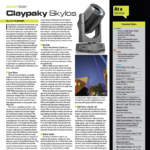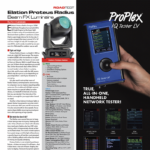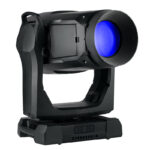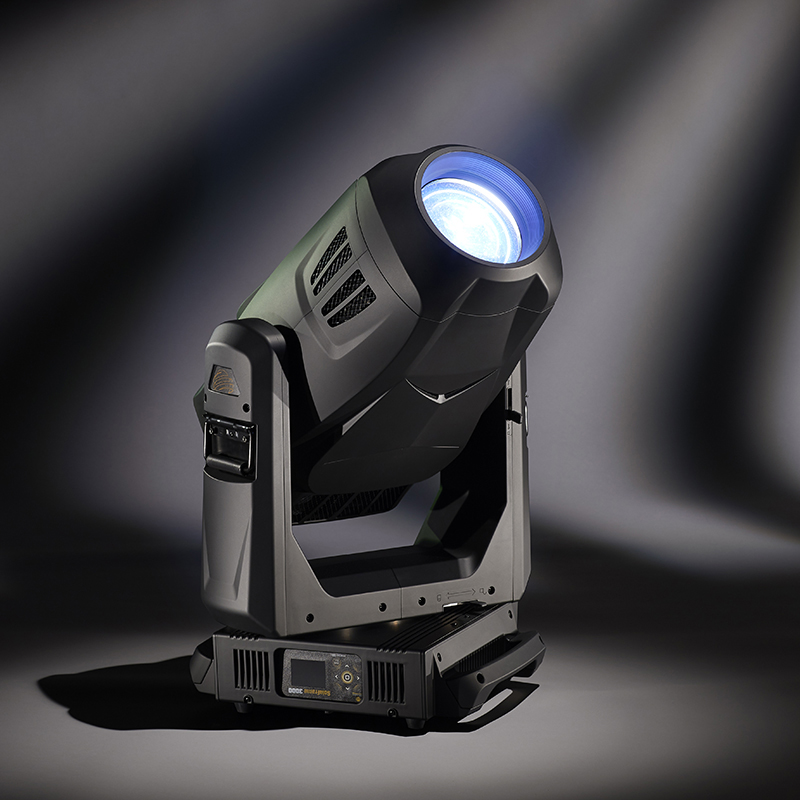
High End Systems continues to stay one step ahead of everyone else when it comes to LED light engine sourced moving profile fixtures. This month’s official release of the SolaFrame 3000, with its 1000W Appotronics light engine, takes brightness in this category of fixtures to the next level. Not just by a skip, but by a monumental jump.
There are two different versions of the 3000 a buyer can choose from, the Ultra-Brite or the High Fidelity models. With more than 37,000 lumens, the Ultra-Brite has greater output and a higher native color temperature. The High Fidelity model offers a higher 95+ CRI, but a lower color temperature and a 25,000 lumen output. For this report, we’re taking the Ultra-Brite on a test drive.
I’m looking at a fixture that is not physically larger than its predecessor, the 2000 model, but it packs about 50 percent more lumens into its output. It also adds 20 percent more muscle, weighing in at 106 pounds. This really isn’t a big deal as HES has placed handles on the base as well as additional handles on the yoke, making it easy to hang from a truss or move around on the deck. The exterior frame is more aesthetically smooth with fewer corners than the previous models in the Sola line. The sexy contours of the molded plastic covers make the fixture physically attractive before I’ve even turned it on. The steel and aluminum frame makes it solid.
The fixture is indeed large, but fits snugly into a piece of Tyler GT pre-rig truss, a must for many in the touring industry. Despite the weight, the fixture can be hung with a pair of clamps at any angle without losing torque on the pan motor. I test out the pan and, for a light this size, it has a little hustle in its movement, taking under three seconds to pan 540 degrees from a dead stop. I test out the circle function and, as with previous models from High End Systems, the fixture’s pan and tilt torque brings a well-executed effect into motion with no delays in processing speed. Pan and tilt locks are in place.

Colors That Bloom
The native color temperature of this fixture is a white-hot 7000K. There is no blue hue around the edges in this white beam. As soon as I roll the magenta and cyan wheels to full, I break out with a big smile. To lighting designers who loved the deep Congo blue color we used to be able to mix in the 90’s, welcome it back. Unlike so many other light beams that seem to dissipate their brightness when mixing a saturated blue, this fixture dares you to try it. Congo blue gobo patterns are easily visible.
The CMY subtractive color mixing system consists of color flags that all come into the focal path from the same angle, eliminating any shifts in color within the beam. I test out the saturation by adding 30 percent magenta to the output. I have a very flat light pink tone. At full, I examine the white wall on which I’ve shined the beam, expecting to see a more saturated line of color down the center where the two flags overlap. I see nothing but a uniformly colored beam, as any good LD would hope for. I color mix green with full cyan and yellow saturation, and I’m pleasantly surprised to see a nice L124 medium green output shine through with the sort of output one normally only achieves with a dichroic color wheel. Speed-wise, the flags do not snap in place, but move at an average speed.
The variable CTO wheel performs as expected, changing the color temperature down to an almost-amber 2800°. One can obtain deeper purples and reds by adding a touch of this to the CMY mixed colors.
The color wheel has six interchangeable color chips, featuring standard red, blue, green, orange and dark blue. I can easily dial in half colors at any percentage I prefer. In the middle of the wheel is a clear filter referred to as the TM-30 filter. When inserted into the focal path, it uses a green subtraction method to change the fixture’s native CRI of 70+ to 85+, thus shifting the color mixing hues. The High Fidelity model, by contrast, comes with a CRI of 95+.
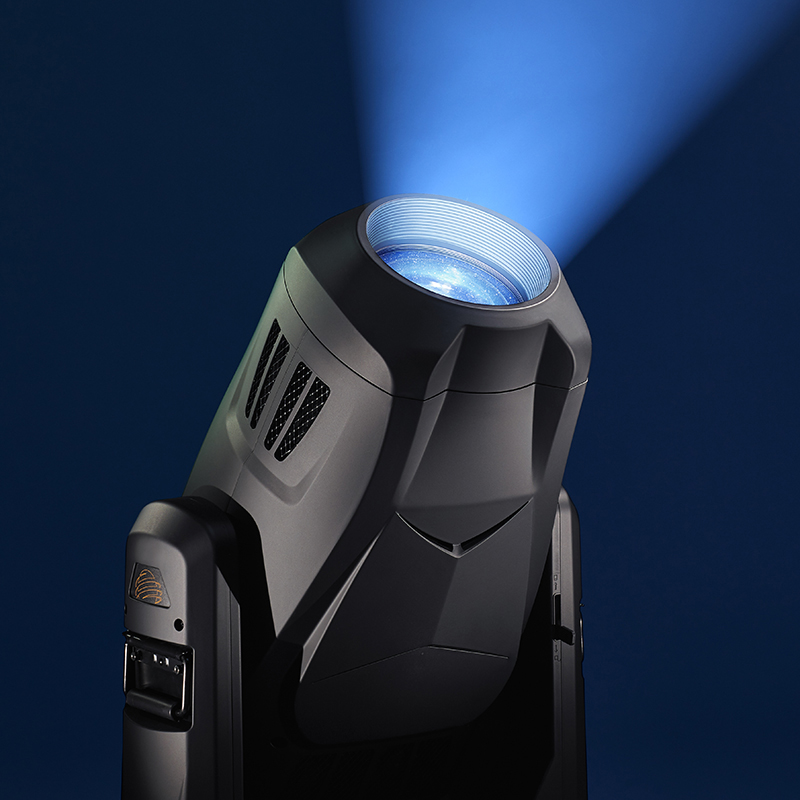
Mixing the Beam
This may be where the fixture stands out. In this day and age of new products coming up with new animation wheel technology and kaleidoscope effects though sealed engines, High End has just come up with better filters and optics to achieve their own special effects. This starts with a single rotating gobo wheel with seven interchangeable slots plus open. Most of these gobos are similar to aerial use beams we have seen in the past that can be fuzzed out and used for textures as well. New and exciting to me was a gobo they refer to as “Ice.” The end result appears as if you have shined a light beam through a clear bowl of ice. It’s not quite shower glass and not quite prism, although the fixture does include a prism. It’s just plain new and cool. If I take and roll a tad of cyan color into the gobotized beam bath, the color refracts into different sections of the beam, making it multi-splintered with several different hues of the one color.
There is a static gobo wheel with seven swappable holes for the user to insert their favorites, and no stamped gobo wheel to restrict the user’s choice of textures. The animation wheel is non-stop, with adjustable speed in either rotation. The wheel itself makes for perfect flames and water effects, especially when mixed with the three-facet rotatable prism.
The variable frost comes in from one direction and can attain anything from a slight frost to a medium frost. Those who desire a full frost capability can swap this lens out for one that achieves that. With a gobo in it, I am able to totally soften the beam but still make out the pattern with the frost at full. Surprisingly, the frost performs evenly across the entire focal path. Kudos to the optics on this fixture.
Speaking of optics, there is a fast zoom. It can cut from a full 55 degrees down to 7 degrees in half a second. I can easily make a sine wave effect that is sweet, just using the zoom function. The fixture has a function allowing the beam to stay in sharp focus when one adjusts the zoom size on a gobotized beam. There is also an iris that can snap down to under 1 degree. It cannot close all the way, but it allows a pin spot beam that is very bright to be emitted.
The four-blade framing system allows for full wipes (curtain reveals) from any blade. The whole system can rotate plus or minus 45 degrees. I can easily make a triangular-shaped beam with the blades, and they certainly move fast enough to be used with chase effects.
The electronic dimming system is perfectly linear, and the strobe functions perform as any user would expect. The fixture contains a macro channel that allows the light source to shift brightness within its internal LEDs to give a flickering camera effect.
I took the beam and added this flicker effect. Then I inserted a half-red/white color filter from the wheel, while adding some yellow and magenta color mixing. I then added the Ice gobo, a rotating prism and a slight frost to it. Finally, I zoomed it down to 25 percent and put the framing shutters in tight enough to resemble the tip of a candle. Despite all the junk I put in the way of the output, I had the perfect candle flame shining on the wall, quite visibly, from 20 feet away.
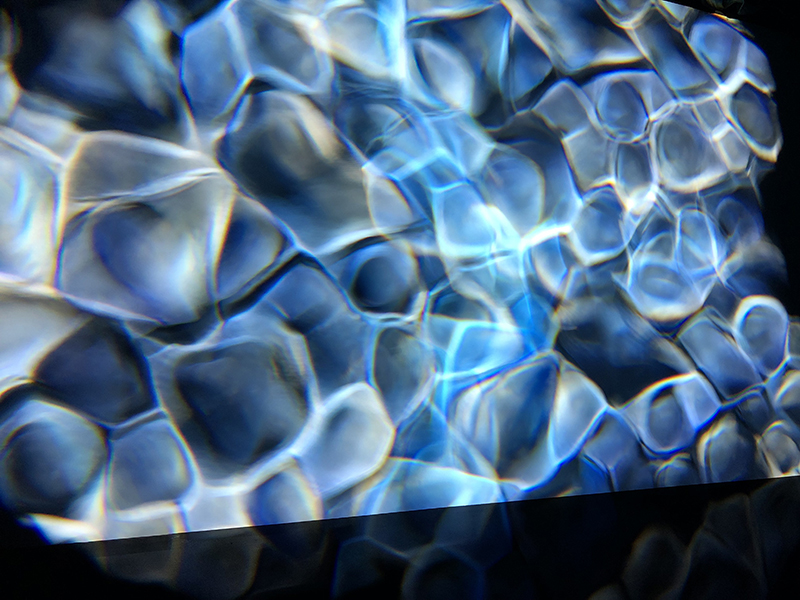
The Nuts and Bolts
The fixture is not small by any means, but not as large as its competitors that use arc sourced bulbs to match this intensity. Two clamps hold it upon a truss. It accepts control via 5-pin XLR or Cat5 RJ45 connectors. A powerCON TRUE 1 AC cable is available for the 100-240 AC voltage the fixture will recognize. The fixture comes standard with the HES-patented lens defogging system and utilizes a maximum of 1541 watts of power to run. The fixture I tested was totally silent, even with fans running. There are three fan modes to affect noise. Even after an hour, I could touch the fixture anywhere, and it wasn’t hot — in fact it was barely warm. The fixture comes with a two-year warranty and the light engine with a five-year one. The fixture runs via DMX, Art-Net or sACN and has one mode that uses 49 channels. It has an IP20 rating.
At a Glance
Big and Bright
High End Systems’ SolaFrame 3000 is big and bright. Well, not so big that it won’t fit in a section of Tyler GT pre-rig truss, but very, very bright. Although the 3000 is only slightly beefier in girth, the Ultra-Brite version’s 37,000-lumen output is almost 50 percent higher than the 26,000-lumen output of its predecessor, the SolaFrame 2000. (The SolaFrame 3000 High Fidelity model is lower in lumens and white color temperature, but has a higher CRI — 95+.)
HES SolaFrame 3000
PROS:
Brighter than any other LED sourced profile on the market. Flat field with perfect optics. Great saturated color mixing that reads. Good choice of effects that all move quickly. Has all the bells and whistles available from any mover. Affordable price point.
CONS:
No shaking gobo effect
FEATURES:
- Fast four blade framing system
- CMY plus variable CTO and color wheel
- Replaceable static and rotating gobo wheels
- Animation wheel and 3-facet prism
- Road case and molded inserts available
SPECS:
- Output: 25,000/37,000 Lumens (High Fidelity/Ultra-Brite)
- Candela: Up to 1,250 footcandles with small zoom at 20’
- Light Source: 1000W LED light engine
- Overall Wattage: 1,541W
- Pan/Tilt: 540°/195°
- Zoom: 7-55°
- Size: 32.3” x 19.3” x 14.5”
- Weight: 106 lbs.
- MSRP: $14,900
Manufacturer: High End Systems/ETC
More Info: www.highend.com
